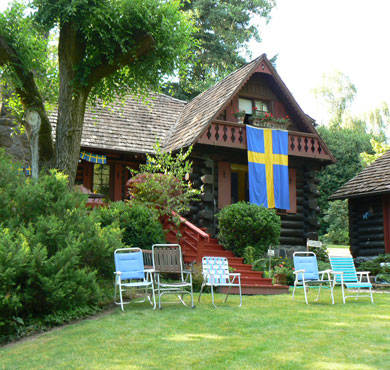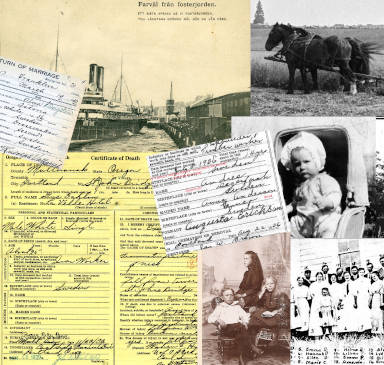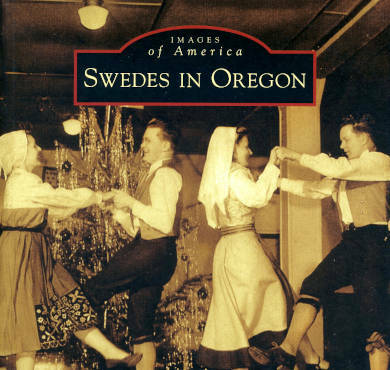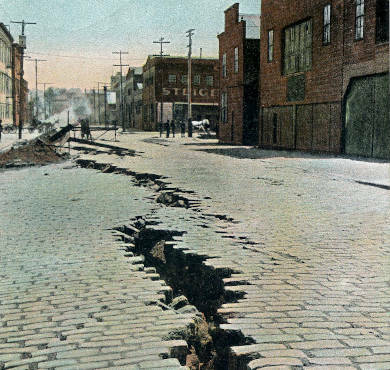Excerpt from Anton Swanson’s Diaries 1908-1911
Introduction
In 1987, the Regional Archives in Östersund, Sweden, received an unexpected gift from a Swedish-American man in Oregon. The gift consisted of a collection of diaries by the donor’s father, Anton Swanson (1883 – 1955), emigrant from Hackås, Jämtland, who had emigrated to the Pacific NW in 1906 and had become a life-long resident of Oregon. The diaries spanned a period of almost fifty years, by itself a unique accomplishment of journal writing. It also quickly became apparent that these diaries, especially those written during the early years, were of such quality that they deserved to be published. In 1989 a selection from the diaries were published as AMERIKAFÄLLAN: Anton Swansons dagböcker 1906 – 1914 [Trapped in America: Anton Swanson’s diaries 1906 – 1914].
So what is it that makes these diaries worth publishing? First of all, they contain interesting information on the Swedish immigrant experience in the urban environment of the Far West at that time, a subject that is not particularly well known. Anton Swanson’s detailed observations take the reader along the never-ending minutiae of his daily life – looking for work, moving from place to place, worrying, documenting how much things cost and what the wages were – in his ongoing attempts to gain a foothold in American society. In addition, we also discover the importance of the Swedish-American newspapers, Anton’s hunger for news from home, his homesickness and regrets, the importance of relatives and friends in the area, many of his thoughts and feelings, his persistent interest in the weather, as well as many charming and humorous comments. Finally, the diaries also record important personal events, such as his marriage in 1908 to Hulda Reinholdsdotter from Småland, the birth of their only child, George Swanson in 1909, as well as the event that was to change his life forever. A few weeks before Christmas in 1909, at age 26, Anton Swanson contracted polio, and even though a long convalescence eventually made it possible for him to walk again, he would never be able to do normal manual labor again. This made it even more difficult for Anton Swanson to find work, and pushed the responsibility of supporting the family onto his wife, a situation that reinforced his sense of helplessness, pessimism and feelings of entrapment. Due to these unfortunate circumstances, we also catch a glimpse of the situation of women in the work force. The Swedish publication of Anton Swanson’s diaries is a “scholarly edition” in the sense that it carefully records the author’s original text, which is far removed from standard Swedish orthography, and provides a glossary and extensive commentary. We have to remember that Anton Swanson was not a well-educated man, did not know how to spell correctly, and was at this point in his life not fully fluent in English. But he was an avid newspaper reader, and he developed a fairly good vocabulary, the only problem being that he regularly made up “Swenglish” words when he could not think of the correct Swedish words. He mostly approached spelling phonetically, which at times makes reading the diaries a challenge. This gives the text a charm obvious to any bilingual Swedish-American reader, but presents a dilemma to the translator: Should one somehow try to preserve and recreate the unique style of the original, or focus on conveying the content of the text? The translator of the diaries, Mary Jean Olsson, has – correctly in my opinion – chosen the latter. For this reason, the American translation has been very lightly edited to reflect, as closely as possible, the meaning and textually concentrated style of the original diary, but has been brought close to standard American English grammar and spelling for the sake of readability.
Anton Swanson left his native Hackås at the end of April, 1906. With six male friends he used the route often preferred by emigrants from Jämtland – a westbound train to Trondheim, then by steamer down the Norwegian coast and across to Hull. From there they followed the route of so many emigrants before them: train to Liverpool, and then an Atlantic crossing on the Caronia, one of the largest ships of the Cunard Line. After clearing immigration in New York, the travelers immediately continued by train toward their final destination, Greenwood, British Columbia. A mining town, Greenwood did not seem to offer the group steady employment, and the friends eventually scattered (one even died). The following spring Anton Swanson moved to Spokane, Washington, where he remained for a year. The diary records the comings and going of his friends, the search for work, and also the name of a Swedish woman named Hulda Reinholds. Anton underlined her name in his journal. In July he decided to look up Hulda’s sister and husband who lived outside Portland, Oregon, and maybe to visit someone else as well …
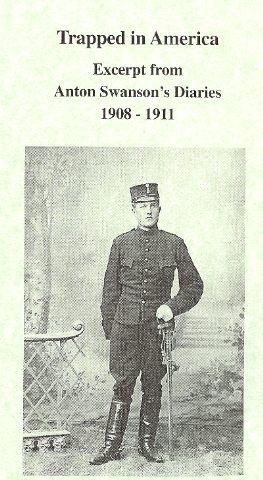
Excerpt from Trapped In Oregon
Anton Swanson’s Diaries
Yes, a New Year has now arrived and we wonder what it has in store. I hope God will be near us and protect his poor children during the coming year as He has done in past years. New Year’s Day: Fine weather, but a cold wind. No work this month either. This has been the worst winter in 20 years in the Western Country. Here in Spokane the snow has been 4 ft deep and the temperature down to 16 below zero. It has been terrible to see the poor guys in town who are both freezing and starving, and who the city must take care of. But fortunately the great minister & preacher Billy Sunday came here, and he collected large amounts and was able to help a lot of roughnecks with room and board. But even so, he struck it rich here in Spokane with his preaching. The last week he was here he took in $11,000 in cash for himself. 28th. Hulda got sick. First we got scared because a woman doctor named Swinger said it was appendicitis. Then we went to another French professor from Paris, Dr. Menetiques, but he was absolutely sure it was not that, so our fears calmed down. He gave Hulda some medicine, but it didn’t help her. Then we went to Dr. Nelson, a Swede, and found out what sickness it was.
February. It was cold, windy and snowed early on, but the weather got better at the end of the month. But there is nothing to do and plenty of men in town. My beloved Hulda still doesn’t feel well. 27th. My dear Hulda left Spokane for Portland to stay with her sister and brother-in-law Linder until she gets to feeling better. She left Spokane at 7 in the evening and at 10 the next day she arrived in Portland. According to the letter I received from her she still felt a bit sick the first days there, just like she had in Spokane. It is a bit cold and windy here in Spokane and nothing to do, but there are plenty of guys. On the 27th I moved from 1503 West 2nd Ave down to Union Hotel on Front Street between Washington and Steven Street. Moved with a Nels Mattson from Småland.
March 1st. Rather nice weather during the first days of the month. 8th. I too left Spokane and went back to Portland where I thought things would be better. When I left at 7 in the evening it was snowing quite hard. The snow was like hail. As usual I couldn’t sleep on the train. When I approached Portland the next day it rained something awful. I then realized that I had left one tough area for one that wasn’t any better. 9th. I arrived in Portland at 10 and went directly to look at the employment listings, but I could immediately see that it almost looked worse than in Spokane. At 3 P.M. I went to Tigardville to see how my dear Hulda was doing. She was feeling a little better now and I was really happy to have her back, as it had been quite lonely in Spokane after she left. 10th. I went to town again to try to find work of some kind and I succeeded. I’m going to sell real estate for the Harding Land Co. in Portland. But after doing it for a couple of days I discovered that there was cheating going on, aimed at me, so I quit before it was too late. Since then I have run all over Portland trying to find work, but have had no luck. 13th. I could have started at the Inman Poulsen Sawmill, but because it had started raining pretty hard I did not want to go there and work outside 11 hours a day, because it is more than I can stand. At the same time I know I am a penniless slave and don’t know what I can do to earn a few dollars for me and my dear Hulda to live on. 21st. Really nice weather. My Hulda is beginning to feel a little better every day and I hope with all my heart that she will get well again so that we can manage, and that poverty will not be too tough on us. 24th. I started working at the Oregon Power and Light Co. where I scale telephone poles for $2 a day. I have an 8hour day and it is pretty nice work, even though it pays poorly. Now it rains a little bit every day.
April 1st. Rain and sunshine every other day. August Lambert from Skåne and I work steady every day. 7th. The first pay day on this job and we heard that we are supposed to get $2.25 a day from the first of this month. We’ll see if it’s true. 8th. My dear Hulda came in to town from Tigardville and we rented a housekeeping room here on 184 Sherman St. One room for $ 6 a month. Hulda is getting better day by day. We’ve had pretty nice weather all month.
May 1st Fine weather. 2nd. There was a pretty good Labor and Socialist Parade here in Portland. In the afternoon the President of the Western Federation of Miners, Wm. D. Haywood, gave a socialist speech at the Skating Rink here. It was a very good speech! 4th. We moved again from Sherman out to16th and Jefferson Street and live in the Jeffersonian Apartments, which are quite nice. 3rd & 4th. Norris and Rows Circus in town. 9th. We went to Tigardville. The weather has been nice these days. (My dear Hulda is beginning to feel quite well again and I hope it will continue to improve. She won’t feel real good until this fall as we expect a little baby.)
June 1st. The days are very nice. 12th. We moved again from Jefferson St back to Sherman St and will see how long we stay here. I and Lamberth from Skåne still work for the same company. Soon we will have been all over Oregon to put up or move light poles. On June 1st the much talked about Alaska Yukon Pacific Exhibition was opened in Seattle. 7,8,9,10,11,12th . The famous Rose Carnival was here in Portland. It was quite magnificent with illuminations, fire works and electric lighting. The Swedish Rose Float portrayed John Eriksson’s Monitor and a Viking Ship. It was well done and very costly. Plenty of people in town during these days. 23rd. The Swedish Midsummer Night Celebration at the California Building here in Portland. 24th. Midsummer Day and nice weather. The Swedes had a party again with a steamboat trip to Estacada and Oregon City. Nowadays I work around Estacada, Boring, Linds & Oregon City. Pretty nice in that county.
